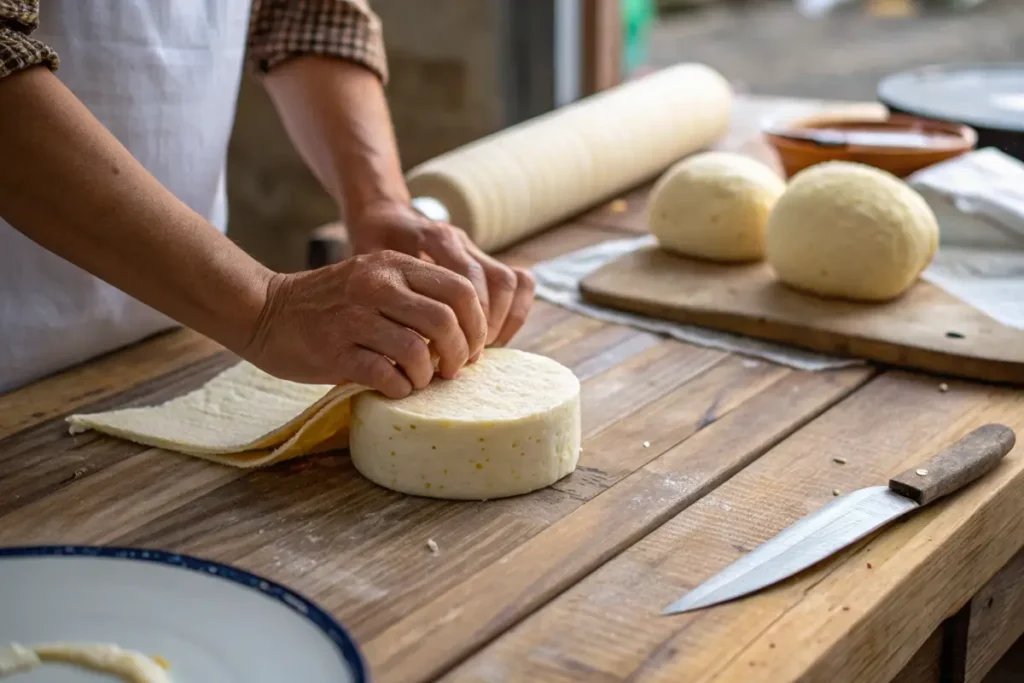Introduction
Cheese lovers, gather around! If you’ve ever wondered, “What’s the difference between queso and quesillo?” you’re in the right place. These two Latin American cheeses might sound similar, but they have their own unique personalities, flavors, and roles in the kitchen. Whether you’re planning a taco night or trying a traditional dish, knowing the distinction can take your cooking (and eating) experience to the next level. Let’s dive into the basics and unravel the mystery behind these delicious cheeses.
Defining Queso and Quesillo
What is Queso?
First, let’s talk about queso. The word “queso” is the Spanish term for cheese. Simple, right? But when we talk about queso in a culinary sense, especially in the U.S., it often refers to a creamy, melted cheese dip. Think about those gooey bowls of queso served with tortilla chips at your favorite Tex-Mex restaurant. Traditional queso, however, can be a variety of cheeses, including fresh options like queso fresco or semi-hard types like queso Oaxaca.
Queso comes in many forms, but it’s known for its mild, milky flavor and ability to complement just about any dish. From sprinkling over enchiladas to melting into a cheese sauce, queso is as versatile as it gets. So, if you’re asking yourself, “What’s the difference between queso and quesillo?” remember that queso can mean a lot of things, but it usually leans toward creamy or crumbly cheeses.
What is Quesillo?
Now let’s shift gears to quesillo. This cheese is a specialty of Oaxaca, Mexico, and is often compared to mozzarella. It’s a semi-soft, stringy cheese that’s made by stretching and kneading curds in hot water, creating long ribbons of cheese that are rolled into a ball. The texture is smooth, and the flavor is mild with just a hint of saltiness. If you’ve ever had quesadillas with stretchy, melty cheese inside, chances are it was quesillo doing all the heavy lifting.
One key thing to note about quesillo is its ability to melt perfectly without losing its structure. It’s a favorite for stuffed peppers, baked dishes, and even just tearing off a piece to snack on. So, again, when asking “What’s the difference between queso and quesillo?” it helps to think about quesillo as a specific type of cheese rather than a broad category like queso.
Historical Origins
The Beginnings of Queso
Cheese has been a part of human diets for thousands of years, and queso is no exception. In Latin America, cheese-making was influenced heavily by European traditions, especially those brought by Spanish colonizers. Over time, local ingredients and methods gave rise to unique cheese varieties like queso fresco and queso blanco. Today, queso is a staple in kitchens from Mexico to Argentina, each region adding its own spin to the cheese-making process.
If you’re still wondering, “What’s the difference between queso and quesillo?” consider this: queso’s roots are broad and diverse, while quesillo has a more focused origin story in Oaxaca.
The Emergence of Quesillo
Quesillo, on the other hand, has a more specific history. Legend has it that quesillo was accidentally created in the Oaxaca region when a young cheese maker left curds in hot water for too long. Instead of throwing them out, she stretched and kneaded the curds, creating the first batch of quesillo. This happy accident has since become a cultural and culinary icon in Oaxaca, with its fame spreading far beyond Mexico.
When comparing “What’s the difference between queso and quesillo?” this historical tidbit highlights one major point: quesillo is deeply tied to its place of origin, while queso has a more universal appeal.
Geographical Variations
Queso Across Different Regions
Because queso is a general term, its characteristics can vary widely depending on where you are. In Mexico, you’ll find options like queso fresco, which is crumbly and used for topping dishes, or queso Chihuahua, which is creamy and perfect for melting. Travel further south to Central and South America, and you might encounter queso costeño, a salty, firm cheese often served with plantains.
In the U.S., queso has taken on a life of its own with Tex-Mex cuisine, where it’s most commonly served as a velvety cheese dip. This diversity is another clue when answering the question, “What’s the difference between queso and quesillo?” queso’s definition depends heavily on location and context.
Regional Interpretations of Quesillo
Unlike queso, quesillo remains closely tied to Oaxaca. Even when it’s made elsewhere, it’s often labeled as “Oaxacan cheese.” Some Central American countries, like Nicaragua, also have their own versions of quesillo, but these are typically thinner and less stringy than the Mexican variety.
So, “What’s the difference between queso and quesillo?” boils down to this: queso is a flexible term for cheese, while quesillo is a specific product with strong regional ties. If you’re ever traveling through Oaxaca, don’t miss the chance to taste authentic quesillo it’s an experience you won’t forget!
Production Methods
How Queso is Made
When it comes to answering, “What’s the difference between queso and quesillo?” the production methods are a great place to start. Queso, being a general term for cheese, is made in many different ways depending on the type. For example, fresh cheeses like queso fresco are made by curdling milk with an acid like lemon juice or vinegar, then draining and pressing it. These cheeses don’t age, which gives them their soft texture and mild taste.
Semi-hard varieties, like queso Oaxaca, involve a more complex process. Rennet is added to the milk to separate the curds and whey, and the curds are then stretched and shaped into long ribbons. In Tex-Mex cuisine, queso often refers to a cheese dip, which is a blend of cheeses (usually cheddar or Monterey Jack) melted down with milk and spices. So, when asking, “What’s the difference between queso and quesillo?” keep in mind that queso can include a variety of methods and end products.
The Process of Crafting Quesillo

Now, let’s talk about quesillo. The process to make quesillo is unique and sets it apart from other cheeses. This semi-soft cheese starts with fresh milk, which is heated and curdled using rennet. The curds are then kneaded and stretched in hot water—a step that gives quesillo its signature stringy texture. The cheese is then rolled into a ball, creating its iconic look.
This process is quite similar to making mozzarella, but quesillo has a slightly firmer texture and a distinct salty flavor. If you’re wondering, “What’s the difference between queso and quesillo?” consider this: while queso is a broad term with endless variations, quesillo’s production is specific and focused on achieving its stretchy, meltable qualities.
The word ‘quesillo’ carries deep cultural significance. Learn more about its meaning here: What is the Meaning of Quesillo?
Texture and Flavor Profiles
Characteristics of Queso
In terms of texture and flavor, queso is a bit of a chameleon. Its characteristics depend entirely on the specific type of queso you’re talking about. Fresh cheeses like queso fresco are crumbly, soft, and moist. They have a mild, slightly tangy flavor that complements spicy or rich dishes. On the other hand, aged quesos, like queso añejo, are firmer with a sharper taste, perfect for grating over tacos or soups.
Then there’s queso as a dip. If you’ve ever had a warm bowl of queso with tortilla chips, you know it’s all about creaminess and spice. The melted cheese combined with jalapeños, tomatoes, or even chorizo creates a savory, indulgent flavor that’s hard to resist. So, “What’s the difference between queso and quesillo?” When it comes to queso, its flavor and texture can change drastically based on how it’s made and used.
Distinctive Traits of Quesillo
Quesillo, on the other hand, has a consistent texture and flavor that make it stand out. Its texture is stretchy and stringy, similar to mozzarella but with a denser feel. This makes it ideal for melting, whether in quesadillas, stuffed peppers, or even as a topping for baked dishes. The flavor is mild and creamy, with just a hint of saltiness that enhances savory dishes without overpowering them.
So, when someone asks, “What’s the difference between queso and quesillo?” the answer is clear: quesillo’s texture and flavor are distinct and reliable, while queso is a more flexible term covering a range of cheeses. If you love that satisfying stretch of cheese when you pull apart a quesadilla, quesillo is the hero behind the scenes.
Culinary Applications
Common Uses of Queso in Dishes
Queso is incredibly versatile in the kitchen. Fresh cheeses like queso fresco are perfect for crumbling over salads, tacos, and soups, adding a light, tangy contrast to bold flavors. Meltable varieties like queso Oaxaca or queso Chihuahua are excellent in quesadillas, enchiladas, or even as a topping for nachos. And, of course, there’s the beloved queso dip, which turns any snack table into a fiesta.
Whether you’re cooking up a traditional Mexican dish or experimenting with fusion recipes, queso can adapt to almost any role. This adaptability is one of the key points in “What’s the difference between queso and quesillo?” Queso can be crumbly, creamy, aged, or fresh, making it a true kitchen MVP.
If you’re wondering how well queso melts, read this article: Is Queso Cheese a Good Melting Cheese?
Popular Dishes Featuring Quesillo

Quesillo shines brightest in Oaxacan cuisine. It’s the go-to cheese for tlayudas, a traditional dish featuring a large, crispy tortilla topped with beans, meat, and quesillo. It’s also a favorite in quesadillas, where its stretchy texture takes center stage. You’ll often find quesillo in chiles rellenos, stuffed into poblano peppers and baked to gooey perfection.
Because of its meltability and mild flavor, quesillo is a top choice for dishes that require a cheese that doesn’t overpower other ingredients. So, when you’re deciding, “What’s the difference between queso and quesillo?” remember that quesillo is all about texture and melting magic, making it a staple in Mexican cooking.
Availability and Market Presence
Accessibility of Queso
When it comes to accessibility, queso is a cheese that’s widely available across the Americas and beyond. From local grocery stores to high-end cheese shops, you can find a variety of queso types to suit your needs. Fresh cheeses like queso fresco are staples in most supermarkets, while aged versions might require a trip to specialty stores.
In the U.S., queso also refers to the popular Tex-Mex cheese dip, which you’ll find not only in restaurants but also in ready-made jars at the store. This accessibility makes queso a household name for many cheese enthusiasts. So, “What’s the difference between queso and quesillo?” One major factor is that queso is much easier to find globally, thanks to its broad definition and widespread use.
Market Availability of Quesillo
Quesillo, on the other hand, has a more niche market. It’s a regional specialty from Oaxaca, Mexico, and while it’s gaining popularity internationally, it’s not as commonly found outside Mexican or Latin American markets. In areas with large Latin communities, you might spot quesillo in specialty grocery stores or shops that cater to traditional Mexican ingredients.
For those wondering, “What’s the difference between queso and quesillo?” availability is a key distinction. While queso is everywhere, quesillo often requires a bit more effort to find—though it’s well worth the search if you’re after that stretchy, meltable goodness.
Cultural Significance
The Role of Queso in Tradition
Queso holds a special place in many Latin American cultures. It’s not just food—it’s a way to connect with traditions, family recipes, and regional cuisines. From queso fresco topping tamales in Mexico to queso costeño paired with arepas in Colombia, queso is more than an ingredient; it’s part of the culinary identity of many nations.
In Tex-Mex cuisine, queso dip has become a cultural phenomenon. It’s a party staple, a comfort food, and a way to bring people together. This versatility is another reason why answering “What’s the difference between queso and quesillo?” often comes back to queso’s broader cultural reach.
Cultural Importance of Quesillo
Quesillo, by contrast, is a symbol of Oaxacan heritage. It’s often referred to as “Oaxacan cheese” because it’s so closely tied to the region’s culinary traditions. Whether it’s used in tlayudas, mole-covered dishes, or street-side quesadillas, quesillo embodies the flavors and craftsmanship of Oaxaca.
So, “What’s the difference between queso and quesillo?” When it comes to cultural importance, quesillo represents a specific regional pride, while queso encompasses a broader, more diverse cultural significance.
Common Misconceptions
Misunderstandings About Queso
One common misconception is that all queso is the same. People often think of queso only as the Tex-Mex cheese dip, forgetting that it’s also a term for traditional cheeses like queso fresco or queso Chihuahua. This misunderstanding can make it tricky to explain, “What’s the difference between queso and quesillo?”—especially when queso has so many meanings!
Clarifying Myths Surrounding Quesillo
For quesillo, the biggest misconception is that it’s the same as mozzarella. While the two share a similar stringy texture, their flavor profiles and production methods are quite different. Mozzarella has a milder taste and is typically made from cow’s milk, while quesillo has a slightly saltier kick and often uses fresh milk from local sources.
Understanding these differences helps clarify “What’s the difference between queso and quesillo?” and allows you to appreciate each cheese for its unique qualities.
FAQs
Is mozzarella the same as queso?
No, mozzarella is not the same as queso. Mozzarella is an Italian cheese known for its mild flavor and stretchiness. Queso, on the other hand, is a broad term for cheese in Spanish and can refer to many different varieties, including fresh and aged types.
What kind of cheese is quesillo?
Quesillo is a semi-soft, stringy cheese from Oaxaca, Mexico. It’s similar to mozzarella but has a slightly saltier flavor and a denser texture. It’s commonly used in Mexican dishes like tlayudas and quesadillas.
Why is it called Quesillo?
The name “quesillo” comes from the Spanish word “queso,” meaning cheese. The suffix “-illo” implies something small or special, reflecting the cheese’s unique qualities and its place in Oaxacan tradition.
Is there a difference between queso and cheese?
Yes, there is a difference. Queso is simply the Spanish word for cheese, but in culinary contexts, it often refers to specific types of Latin American cheeses or the popular Tex-Mex cheese dip. Cheese, in general, is a global term encompassing all types of cheeses worldwide.
Conclusion
So, “What’s the difference between queso and quesillo?” It’s all about variety versus specificity. Queso is a versatile, catch-all term for cheese that takes many forms across Latin America and beyond. Quesillo, on the other hand, is a regional specialty with a unique texture and flavor that’s tied to Oaxaca’s culinary heritage. Whether you’re a fan of crumbly queso fresco or the stretchy magic of quesillo, both have a special place in the world of cheese. Next time you’re at the store or planning a recipe, give each one a try—you won’t be disappointed!

